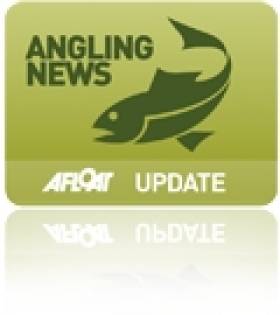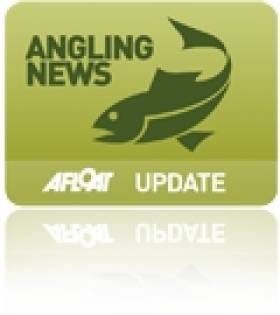Displaying items by tag: Lackagh
Salmon & Sea Trout Fishery Stocks Improve in Letterkenny Fisheries
Mr. Joe McHugh T.D., Minister of State at the Department of Communications, Energy and Natural Resources, has approved a suite of regulations and bye-laws that will govern the wild salmon and sea trout fisheries in 2015. These will come into effect from Thursday 1 January 2015.
Minister Mc Hugh highlighted the progress made in relation to two Rivers in the Letterkenny Fishery District.
The Minister said, "major angling development works are already underway to enhance the highly scenic River Lackagh as a salmon and sea trout fishery. In the latest annual scientific assessment the Lackagh remains open to catch and release angling for 2015 but the deficit in the salmon stock has moved significantly closer to the Rivers conservation limit which once surpassed will facilitate a full opening of the fishery"
"The partnership approach between the Creeslough Angling Club, and Inland Fisheries Ireland (IFI) in a joint management plan for the fishery is making real progress. Salmon numbers have improved steadily on the fishery in recent years with the fishery re-opened on a 'catch and release' basis for the past two seasons. The key issue is to bring the River above its conservation limit and to build on the good work to date. This will require continued collaboration and maintaining patience for the future good of the fishery – it's about staying the course", he added
The Minister recently visited the River to view for himself significant upgrades to facilities along the lower reaches of the river near Creeslough village. The majority of the work was carried out by TUS workers, with materials and additional labour supplied by IFI. The salmon Conservation Fund administered by IFI, has already funded a series of enhancement measures and work in ongoing to secure a major capital project for the fishery next year to install a crump weir and fish counter.
"This is real partnership in the Community with the local club working side by side with the State Agency to enhance their river and its fishery" said Minister Mc Hugh. "The club deserves great praise for its efforts and its forbearance, as do IFI for their excellent support, while we wait for the recovery in salmon numbers to hopefully continue its upward curve" he added.
The Minister also noted the improved stock status in the River Leannan which has moved from being completely closed in 2014 to being open for catch and release angling for 2015. The improved status will allow anglers to catch fish and thereby provide a useful index of salmon numbers in the river before releasing the fish to bolster spawning.
Minister Mc Hugh said, "this is also god news for the Leannan in that it is also moving in the right direction, however all concerned anglers and IFI must nurture this new status and continue to contribute towards building on improvements in the salmon numbers". "While this is a positive development, what the Leannan needs now is again a sense of restraint and a resolution from all stakeholders to ensure that forward movement is maintained" he added.
Major Angling Development on the River Lackagh, Co Donegal
#angling – Minister of State, Joe McHugh TD, visited the River Lackagh, Co Donegal, on Monday 20th October to view at first hand major angling development works currently underway to enhance this highly scenic salmon and sea trout fishery.
As part of an overall joint management plan for the development of the fishery, the Creeslough Angling Club, in conjunction with Inland Fisheries Ireland (IFI), have completed a major upgrade and expansion of angler access and car parking facilities along the lower reaches of the river near Creeslough village. The majority of the work was carried out by Tús community work placement workers, with materials and additional labour supplied by IFI.
Commenting on the visit, Minister McHugh said: "I had a very positive visit to the River Lackagh where I had an opportunity to see for myself the very encouraging development carried out on the upgrading and expansion of facilities at the fishery and the great work being carried out by all groups, including the Creeslough Angling Club, the IFI and on a broader level, the Donegal Angling Tourism Alliance.
"I would like to thank those present for giving clear and concise briefings on how developments are underway and outlining where they believe the future of angling for the River Lackagh and the surrounding lakes is heading. There are many opportunities here which are being pursued by local and national groups and I commend them on their hard work to date and look forward to working closer and supporting where I can, as Minister and within the Department of Communications, Energy and Natural Resources."
Previous developments on the fishery, funded mainly under the Salmon Conservation Fund administered by IFI, have seen a series of fishery and habitat enhancement measures completed including introduction of spawning gravels, fish passage improvement, selective bank clearance and erection of livestock fencing along key river bank sections. Salmon numbers have improved steadily on the fishery in recent years with the fishery re-opened on a 'catch and release' basis for the past two seasons.
Milton Matthews, Director, Inland Fisheries Ireland, briefed Minister McHugh on progress towards securing a major capital project for the fishery next year which would see a crump weir and fish counter facilities installed on the river. If successful, this proposal would represent the first such counter along the north Donegal coast.
Niall Gallagher, Paddy Boyle, chairman and secretary of the Creeslough AC, and consultant Kevin O'Connor, presented a copy of the 'Future Development plan for angling tourism and conservation of the Creeslough Fisheries to the Minister. The plan details future angling development proposals for the River Lackagh system and surrounding lakes including creation of additional angling spaces on the Owencarrow River, as well as provision of improved access, parking and mooring facilities at Glen Lough, Natooey and Roosky lakes.
The plan represents one of a number of similar projects developed by the Donegal Angling Tourism Alliance (DATA), a group formed in 2012 to promote game and sea angling in Donegal in partnership with Inland Fisheries Ireland.
Dr. Ciarán Byrne, CEO of Inland Fisheries Ireland, expressed his delight with achievements to date in Donegal, highlighting what can be achieved jointly by local angling clubs and interest groups working closely in partnership with IFI to secure development and long term sustainable management of fisheries. He commented: "Inland Fisheries Ireland is delighted to lend its support to the Donegal Angling Holidays initiative for the promotion of game and sea angling in the region."

























































